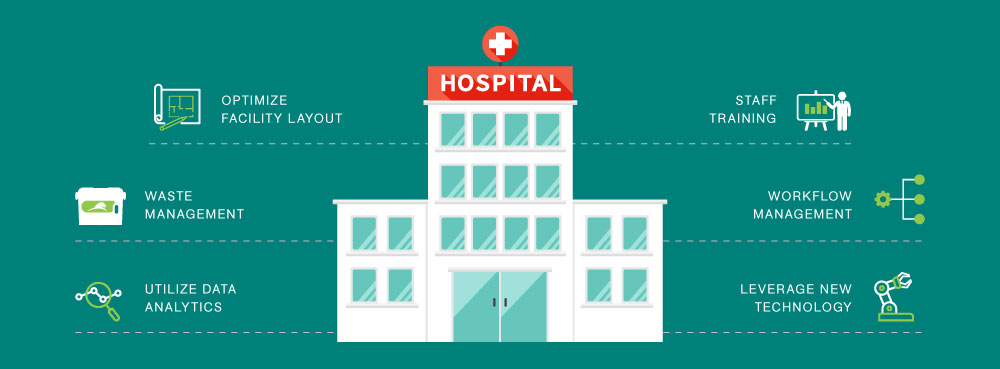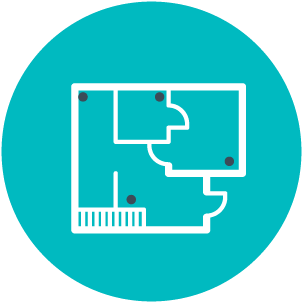Strategies To Optimize Work Efficiency At Your Healthcare Facility

Healthcare facilities are under continuous pressure to increase efficiency wherever they can. As a result, many healthcare providers have begun to focus on identifying and eliminating bottlenecks and barriers to delivering services in a timely manner. Exploring a few proven ways to help workers boost their productivity and help your healthcare facility improve its efficiency can benefit everyone within your organization as well as the patients you care for. Here are a few tips to make you day-to-day life easier.
TOPICS WE WILL COVER
2 / Focus on Efficient Workflow Management
3 / Consider Attaching RFID Tags to Equipment
4 / Optimize Facility Layout for Efficient Navigation
6 / Streamline Waste Management
7 / Utilize Data Analytics to Identify Potential Areas for Improvement
Begin With Training
When it comes to efficient and effective healthcare, everything ties back to the skill of an organization’s workforce. Healthcare facilities need a well-trained staff of medical providers to handle the complex and heavy demands they face every day in an efficient manner. This means that organizations should invest in regular training, including workshops and symposiums, that can provide staff with the additional knowledge and skills they need to boost both the quality and efficiency of the services they provide. Change is a constant in the healthcare industry, so continuing education is a constant priority for any high-efficiency facility.
Focus on Efficient Workflow Management
Simply scheduling and assigning workers to every role is not enough to efficiently manage workflow. Healthcare facilities often face complex variations and transitions in workflow between managing different services. This often results in bottlenecks and barriers to efficient workflow and an opportunity for improvements.
A good start for this is to add tasks based on the knowledge and expertise of workers. This can start right from hiring by identifying the skills new hires can bring and assigning them to roles in which they will require the least training and perform best. In cases in which a candidate may possess multiple skill sets, managers may also consider allowing workers to perform multiple roles to boost productivity.
This process certainly does not have to stop with hiring. Managers can also review existing staff to determine what outstanding skill sets workers hold and where they can best apply these skills. Managers who do this ensure they have the best person for the job and help show staff they notice their talents. This will also help workers to grow and build even greater skills in their areas of expertise.
Consider Attaching RFID Tags to Key Equipment
RFID, or radio frequency identification tags, are a relatively new introduction to the healthcare environment. However, they are quickly becoming a key tool for improving efficiency. RFID tags are essentially small chips medical facilities can attach to equipment, and these tags then broadcast information, including real-time location, to readers.
One of the most valuable applications for this technology is to locate key equipment, preventing its loss or misplacement and the costly replacement and lost time that can result. Facility managers can also use this technology to track and review how they store their equipment and move it through their facility in order to maximize efficiency.

Optimize Facility Layout for Efficient Navigation
Healthcare facilities are invariably filled with staff and patients traveling between key areas as they deliver and receive services, and recent research has begun to demonstrate the key role facility design can play in staff and patient wellness. An efficient layout can help to ensure that key or related areas can flow efficiently as needed while ensuring that people can flow effectively between areas with minimal cross-traffic. Some improvements could include the following:
- Providing clear signage to direct staff and patients through the facility.
- Creating a sequential flow through the facility whenever possible to prevent patients from needing to backtrack to reach their next area.
- Ensuring that patient rooms are well-stocked with essential supplies to prevent unnecessary supply runs.
- Provide staff with standing workstations to allow for quick access to records and note-taking.
Leverage New Technology
New technology is continuously being introduced with the promise of removing obstacles and improving efficiency. The truth is that though some technologies do not pan out as they should, many can work wonders when it comes to improving productivity.
For example, digital communication apps can streamline the transmission of schedules, spreadsheets, and other information without the need for printing and physical distribution. Project management software can keep everyone on track and ensure operations proceed smoothly.
Keeping abreast of new technologies can help to increase efficiency continuously. However, it is just as crucial to acquire feedback from staff before and after making any changes. Additionally, healthcare facilities should also ensure they train their employees in the use of any new technologies and respond to any concerns.
Streamline Waste Management
Proper waste management is key to protecting patients, staff, the public, and the environment from exposure to hazardous waste materials. Given that healthcare facilities must regularly deal with waste of this nature, efficient handling is a must. However, for many facilities, waste management is a major source of inefficiency that contributes to staff fatigue, burnout, and negative impacts on both staff and patient safety.
Traditional medical waste disposal often uses multiple containers, including flimsy bags that can present hazards to staff and single-use exterior containers that must be individually disposed of. This leaves the disposal process not only dangerous and wasteful but needlessly time intensive.
However, your facility can greatly improve workflow and reduce exposure if it invests in a modern waste management system engineered for safety and efficiency. Daniels Health designs every waste solution with efficiency in mind. For instance, our Sharpsmart sharps container utilizes innovative technology that neatly stacks sharps inside its secure interior, rather than them being stored in a haphazard, space-wasting configuration.
Our reusable Medismart waste containers remove the need for bags and incorporate versatile mounting accessories that allow them to effortlessly be moved from a wall to a trolley or mobile cart, ensuring a clean and effortless collection of waste. This innovative approach extends to bulk storage units designed for standard corridor sizes to help ensure minimal space use while performing bulk collections in tight spaces.
Using Daniels intuitive waste system allows personnel to conveniently load many units onto a single cart for disposal without worrying about messy bags or complex disposal mechanisms. This simplifies the entire disposal process, preventing wasted labor and time while providing the highest degree of safety. The Daniels team is happy to provide guidance with adoption of our system, providing just the services your specific facility needs without any extraneous products or services as well as optimizing your waste program to ensure efficient cost savings.
Utilize Data Analytics To Identify Potential Areas for Improvement
When it comes to making improvements to efficiency, it can help to identify what processes are most in need of change. This should start with an internal review of processes to find which operations add value and which do not.
However, as modern technology has been introduced into many facets of healthcare management, there is a growing wealth of data that can be used to help identify bottlenecks and inefficiencies. Further, this data can help to track what works and what does not when attempting to make changes.
Conclusion
Now more than ever before, healthcare organizations are struggling to boost their productivity and remove inefficiencies. The strategies presented above can help these facilities to improve their processes and remove potential bottlenecks that can prevent workers from getting more done without feeling the pain of burnout. As you make changes to processes to boost efficiency, you should make sure you identify where you are making progress and where you could make further improvements. Healthcare facility managers should review their processes and introduce these strategies where possible to make their facilities run more efficiently.
Let's Talk!
Your time is valuable, and we don’t want to play hard to get. You can either phone us directly on the details listed on our contact page, or feel free to fill out this short form and one of our team members will get back to you as quickly as possible.
